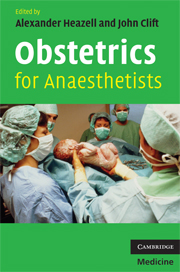Book contents
- Frontmatter
- Contents
- List of contributors
- Foreword
- Preface
- Acknowledgements
- List of abbreviations
- 1 Maternal physiology and obstetrics
- 2 Antenatal care
- 3 Induction of labour
- 4 Normal labour
- 5 Abnormal labour
- 6 Fetal monitoring
- 7 Pre-eclampsia and hypertensive disorders of pregnancy
- 8 Operative obstetrics
- 9 Obstetric haemorrhage
- 10 Thromboembolic disorders of pregnancy
- 11 Infection
- 12 Life support in obstetrics
- 13 Drugs in obstetrics
- 14 Confidential enquiries into fetal, neonatal and maternal death
- Appendix 1 Adult Advanced Life Support Algorithm
- Appendix 2 The Management of Postpartum Haemorrhage Algorithm
- Appendix 3 Emergency Management of Eclamptic Fit Algorithm
- Index
- References
5 - Abnormal labour
Published online by Cambridge University Press: 21 August 2009
- Frontmatter
- Contents
- List of contributors
- Foreword
- Preface
- Acknowledgements
- List of abbreviations
- 1 Maternal physiology and obstetrics
- 2 Antenatal care
- 3 Induction of labour
- 4 Normal labour
- 5 Abnormal labour
- 6 Fetal monitoring
- 7 Pre-eclampsia and hypertensive disorders of pregnancy
- 8 Operative obstetrics
- 9 Obstetric haemorrhage
- 10 Thromboembolic disorders of pregnancy
- 11 Infection
- 12 Life support in obstetrics
- 13 Drugs in obstetrics
- 14 Confidential enquiries into fetal, neonatal and maternal death
- Appendix 1 Adult Advanced Life Support Algorithm
- Appendix 2 The Management of Postpartum Haemorrhage Algorithm
- Appendix 3 Emergency Management of Eclamptic Fit Algorithm
- Index
- References
Summary
Introduction
Abnormal labour represents a large proportion of obstetric and anaesthetic work load on the labour ward.
Pre-term labour
Preterm labour is defined as the onset of spontaneous contractions before 37 weeks gestation. In current practice, intervention in the form of tocolysis would usually be considered in women presenting with contractions prior to 34 weeks gestation in view of the significant implications for perinatal morbidity and mortality in these cases. Preterm delivery is the leading cause of neonatal mortality. The survival rate of babies born in the developed world now ranges from 17 % for babies born at 23 weeks to over 90 % for babies born at 30 weeks. Mortality rates are directly related to both gestation and birthweight, with birth weight being a better predictor of survival after 29 weeks gestation. Multiple pregnancies are associated with poorer neonatal survival rates when compared to singleton pregnancies at the same gestation and neonatal mortality is significantly higher in male infants. In addition to neonatal mortality, prematurity is associated with significant long-term morbidity and disability. Significant ongoing motor impairment occurs in approximately 1 in 4 low-birth weight infants (< 1500 g) and approximately 1 in 3 have hearing or visual impairments. Premature and low-birth weight babies are also more likely to have chronic lung disease, require hospital admission for acute illness and develop cardiovascular disease in later life.
There are a number of identifiable risk factors associated with preterm labour, which are listed below.
Keywords
- Type
- Chapter
- Information
- Obstetrics for Anaesthetists , pp. 40 - 51Publisher: Cambridge University PressPrint publication year: 2008



